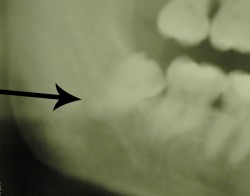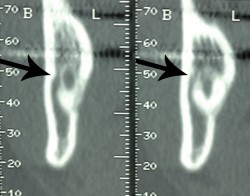Wisdom tooth
The wisdom tooth does may often remaining deep in the lower jaw or maxilla because of the lack of room to erupt. This posterior and deep position into the bone is inconvenient for removal and surgical expertise is required to reduce the risks: local infection, always possible in a septic environment such as the oral cavity, and hemorrhage.
When the wisdom tooth is located in the upper jaw, the typical complication is the formation of a fistula between the oral cavity and the maxillary sinus, substantially a communication between the maxillary sinus and the oral cavity that involves the passage of air, liquids and sometimes food towards the nose. The discomfort is obvious and a specific surgical treatment is necessary to correct it.
In the mandible there are two nerve structures are at risk: the inferior alveolar nerve, providing the sensitivity of the teeth, lip and chin on the same side, and the lingual nerve, in charge of the sensitivity of half tongue.
Special surgical skills are necessary to correctly manage the delicate relationship between the wisdom tooth and these nerves, whose lesion involves the anesthesia of the target regions, sometimes annoying paresthesias (tingling, burning, etc.), and other times continuous pains that ruin dramatically the quality of life of patients.
In the most difficult cases, or simply for those who feel more comfortable with it, it is possible to carry out the extraction under sedation.
Sedation
Sedation is obtained by administering drugs that, in addition to local anesthesia, lower the patient’s level of consciousness, making pleasant the surgical experience.
Sedation is indicated for major outpatient surgeries, operations lasting more than 45 minutes, those one that would be painful under simple local anesthesia, and finally for patients who do not feel comfortable to face the surgery completely awake.
Before sedation, an anaesthesiologist visits the patient and examines the prescribed tests. While the surgeon performs the surgery, the anesthesiologist administers sedation drugs and takes patient’s parameter under control by appropriate monitors.
Unlike an operation conducted under general anesthesia, the post-operative observation time is very low, and the patient is able to go back home in a short time.
The S.A.M.A. anaesthesiology team works at Dr. Schiappadory office to carry out safely the sedation.




